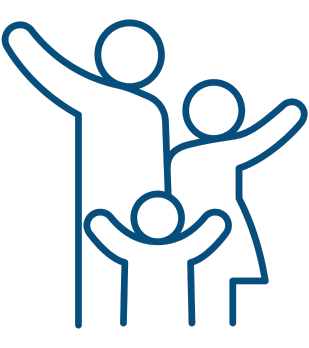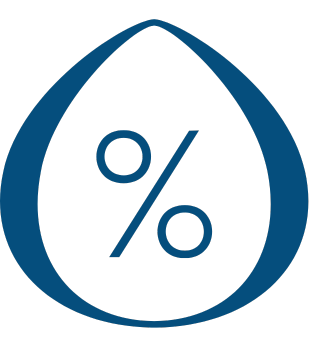Migraines are a problem that can severely damage your quality of life. The throbbing pain of a migraine, accompanied by nausea, vomiting and sensitivity to light or sound, can interfere with normal life and work. Even after the main symptoms have passed, fatigue, exhaustion and reduced ability to work may continue for several days. Although migraines cannot be cured completely, severe attacks can be prevented. In this article, together with Drops Clinic Family Clinic specialists, we will discuss what causes migraines and how we can improve our well-being in the face of them.
Our servicesMigraine – what is it?
Migraines are a common and severe form of headache. Migraine pain can be so intense that it becomes impossible to live and work normally. Migraines usually present with a tingling or throbbing pain on one side of the head, and may also be accompanied by nausea, vomiting and hypersensitivity to light, sound or smell. Migraine attacks can last from a few hours to a few days and recur regularly. Migraines are associated with disorders of the blood vessels in the brain and changes in the functioning of the nervous system. The causes of migraine and the factors that can provoke it are varied and individual to each person. Migraines can also be characterised by changes in mood and behaviour, irritability, irritability, reduced work capacity, and symptoms may be felt for several days after the attack.
The most common types of migraine:
- Migraine without aura is the most common type of migraine, and is characterised by intense, splitting headaches, usually on one side of the head.
- Migraine with aura – less common and characterised by severe headache and visual, sensory or motor disturbances (numbness in the limbs, dizziness, etc).
- Chronic migraine – diagnosed when the headaches recur for more than half the days of the month and at least 8 of them are accompanied by a severe stifling pain.
- Ophthalmic migraine – in addition to headaches, there are also symptoms related to vision.
- Vestibular migraine – diagnosed when the headache is accompanied by persistent severe dizziness.
Signs and symptoms of migraine by phase:
Migraines usually present in four stages, each with different symptoms and intensity. Not all migraine sufferers experience all of these phases, and they can vary in duration and intensity. The phases of migraine are: prodrome, aura, attack and postdrome.
Prodrome (Alert phase)
A prodrome is the first phase of a migraine, usually starting 1-2 days or a few hours before a migraine attack. During this phase, a person may notice subtle changes in his or her mood, appetite, energy levels or physiological processes that warn of an impending migraine attack. The prodrome phase occurs in the majority of migraine sufferers, but not before every attack. Signs of the prodrome phase may include:
- mood changes;
- food cravings, desire to eat unusual foods;
- lack of appetite;
- fatigue;
- bloating;
- constipation or diarrhoea;
- stiff neck;
- severe thirst;
- increased urge to urinate;
- fluid accumulation;
- frequent yawning.
The Auric period
The aura period is the second phase of migraine, occurring before or during a migraine. The aura period does not affect everyone – only about 20-30% of migraine sufferers. Migraine without aura is a much more common type of migraine, affecting 70% of people.
The aura period can last up to 60 minutes, but usually lasts between 5 and 20 minutes and ends before the onset of a severe headache. The aura period is associated with visual, speech or sensory disturbances due to changes in cerebral blood flow. The following symptoms may occur during the aura period:
- visual phenomena such as flashes of light, flickers, dark spots or tunnel vision;
- visual impairment or loss;
- tingling or numbness on one side of the body;
- inability to speak clearly;
- feeling heavy or numb in the arms and legs;
- ringing in the ears;
- changes in smell, taste or touch.
Seizure
An attack is the third and main phase of migraine – the headache period. An attack can last from 4 to 72 hours and can be intense and interfere with daily activities. During an attack, a person becomes very sensitive to light, sound, smell or touch and experiences nausea or vomiting. The following symptoms may occur during the seizure phase:
- pain is usually on one side of the head;
- a tingling headache or a throbbing sensation in the head;
- sensitivity to light, sound, smell or touch;
- nausea or vomiting;
- visual disturbances;
- general weakness.
Migraine headaches are most often felt on waking and usually worsen with physical activity. It is most often felt on one side of the head, but can move from one side to the other, and can be felt all over the head or in front of the head.
Postdrome (Recovery phase)
Postdrome is the fourth and final phase of migraine, which starts after a migraine attack and lasts for hours or days. This is the recovery period. During this phase, pain is less frequent, but the person may feel tired, exhausted, confused and irritable. Signs of the postdrome phase can include:
- fatigue;
- relief or recurrence of headaches;
- insomnia or drowsiness;
- mood swings;
- food cravings or lack of appetite;
- food intolerance;
- difficulty concentrating.
Causes of migraines
The causes of migraine are not entirely clear and scientists say it is linked to genetic and environmental factors. Migraine is also thought to be a disorder of the blood vessels in the brain, which causes changes in nervous system activity and the transmission of pain signals. Migraine can be influenced by hormonal changes, stress, sleep deprivation, food allergies or malnutrition, and these factors affect the recurrence of migraine attacks.
Kas sukelia migreną?
What causes migraines?
- hormonal changes – menstruation, pregnancy, menopause, taking contraceptives;
- anxiety, depression, emotional fatigue and stress – emotional or physical;
- sleep deprivation, altered sleep patterns, sleeping too long;
- intense physical exertion or overexertion;
- certain foods – chocolate, cheese, citrus fruits, seafood, coffee, MSG;
- Alcohol – especially wine and beer;
- dehydration and lack of fluid in the body;
- Changes in climate and weather conditions – sudden changes in temperature or pressure, stuffy, dry or humid weather;
- light – bright or flashing light, sunlight;
- Sound – noise, music, loud noises;
- smell – strong or unpleasant odours, smoke;
- physical exertion – sport, sex;
- neck or head injuries;
- some medicines, especially contraceptives or hormonal drugs;
- certain diseases – hypoglycaemia, hypertension, sinusitis.
Migraine triggers are individual to each person and not always easy to identify. The same factor does not always trigger a migraine. However, it is important to learn how to recognise migraines and their symptoms and to keep track of your condition – your eating and sleeping habits, the medicines you take, the weather conditions and pressure, and changes in your routine.
When should I see a doctor?
Migraine is a serious and difficult-to-control condition that requires medical advice and appropriate treatment. If you are experiencing migraine symptoms and they interfere with your normal life and work, you should contact your family doctor or a neurologist. You should also seek immediate medical attention if you:
- Migraine attacks are frequent (more than 4 times a month) or prolonged (more than 3 days);
- migraine symptoms are severe or interfere with daily activities;
- migraine symptoms change or new ones appear;
- the onset of a migraine attack is sudden and intense;
- the migraine attack is accompanied by fever, neck pain, loss of consciousness or other serious symptoms;
- the migraine headache is very severe, intolerable or different from previous migraine attacks;
- the headache starts after an injury;
- migraine attacks become more frequent or severe;
- you are not sure whether your headache is a migraine or some other cause.
How to treat migraines?
Although migraine itself is not completely curable, migraine attacks and the pain they cause are treatable. The treatment of migraine pain is individual and depends on the patient, their age, condition and the type of migraine. The most common treatments for migraine are:
- prescription or non-prescription medicines for pain and other migraine symptoms (such as vomiting or nausea);
- lifestyle changes, avoiding migraine triggers (certain foods, sounds or stress);
- hormone therapy if the migraine is related to hormonal changes;
- alternative therapies (meditation, acupuncture);
- intravenous therapy.
If you experience frequent headaches, especially on one side of your head or with throbbing, it is advisable to consult your family doctor or a neurologist for a professional assessment, an accurate diagnosis and appropriate migraine treatment.
Treatment of migraine with intravenous therapy
Treating migraines with intravenous therapy is one of the most effective ways to manage migraine pain and other symptoms. Intravenous therapy is a treatment where medication is given directly into a vein by drip. This method allows you to quickly and safely achieve the desired concentration of the medication in your bloodstream and ensure its effectiveness. Intravenous therapy also reduces the risk of side effects and helps prevent gastrointestinal problems. Intravenous therapy can be used as:
- Attack treatment – when migraine pain is severe and not relieved by conventional painkillers. Intravenous therapy can help reduce migraine headaches and nausea;
- preventive treatment – when migraine attacks are frequent and difficult to control by other means;
- dehydration treatment – when migraine attacks are caused by a lack of fluid in the body;
- vitamin and mineral supplementation – when migraines are caused by a deficiency or imbalance of nutrients in the body. Intravenous therapy may include vitamins (e.g. B, C, E), amino acids or minerals (e.g. magnesium, zinc, selenium) to help improve brain function and immunity;
- detoxification – when migraines are linked to poisoning or toxin build-up in the body. Antioxidants can be administered through intravenous therapy to help remove toxins from the body and restore its balance;
Migraines and the symptoms they cause can severely reduce your quality of life and interfere with your ability to live or work normally. Migraine headaches, which are throbbing and intense, usually on one side of the head, make it impossible to carry out daily activities, to work and even to move around. Although migraine itself is not completely curable, it is possible to prevent attacks, so it is important to keep track of your condition and to learn how to recognise migraine, its symptoms and the factors that can trigger an attack. These factors are individual for everyone. For some it may be foods (such as cheese or coffee), for others it may be hormonal or even changes in the weather.
If you get a migraine, don’t rush to treat the pain yourself, but instead turn to Drops Clinic’s expert team of doctors who are always ready to help you regain your quality of life. Our team is made up of professionals with exceptional skills and qualifications, using only the latest state-of-the-art medical equipment. We work only with certified products from world-renowned manufacturers. After listening to your complaints and preferences, and based on the detailed examinations carried out, our professional doctors will select the most suitable treatment for you.
register for a visit



